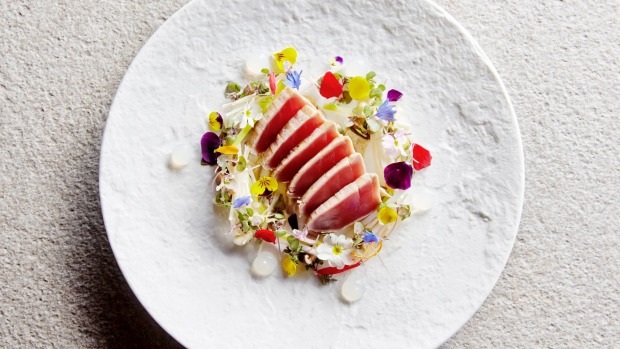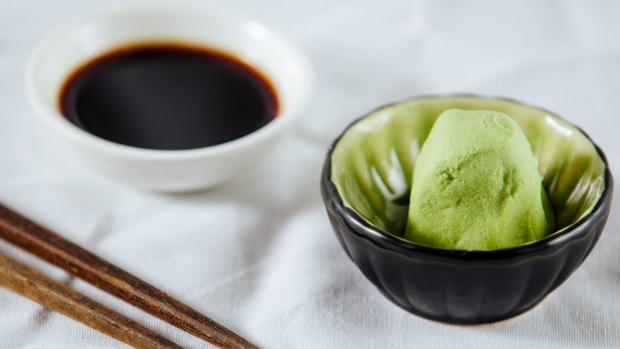Up close with Sepia sashimi
Martin Benn delicately prepares some delicious sashimi.
Consider the legendary Sukiyabashi Jiro in Tokyo. At the three-Michelin-star restaurant and subject of the documentary Jiro Dreams of Sushi, cooks apprentice for a decade at minimum and must become expert at handling the fish before they're even allowed to pick up a knife and cut it.
Daisuke Nakazawa did his time at Jiro for 11 years, but he is not that hardline of a chef. (You might remember him as the guy in the documentary who had to make the egg sushi tamago 200 times before he got the master chef's approval.)

At his own place, Sushi Nakazawa in New York's Greenwich Village, he's relaxed. He jokes with customers – his sweet smiling face is all over social media – and he estimates that he interacts with 70 percent of guests sitting at his sushi bar, crediting his customers for helping him learn English. (Still, his answers below are via a translator.)
Though less strict, the man still has rules. Expect them to be in effect at his upcoming restaurant at the Trump International Hotel in Washington, where he plans to serve a similar menu to the one in New York. Now behave, and enjoy your sushi.
Be on time - seriously
All restaurants get annoyed with late arrivals. But at an elite sushi bar, where everyone is served at the same time, showing up after your scheduled reservation really messes up the flow. If the hay-smoked sockeye salmon is the third piece of your omakase menu, you can't expect the chefs to go back and prepare the soy-marinated king salmon or the big fin reef squid you might have missed. And if you're more than 30 minutes late, you won't be seated, period.

Don't go crazy with the condiments. Photo: Tim Grey
Don't ask for wasabi or soy sauce
Late times are bad, but if there's one way to make a sushi chef go ballistic – at least internally – it's watching a customer mash a mound of wasabi in a pool of soy sauce and then dunk the sushi in it. So it bears repeating: At a good sushi bar, every piece is precisely composed by the chef. Not only are you insulting the chef with your soy-wasabi bath, you're upsetting the delicate flavour balance of a piece of fish that you're paying a lot of money for (at Nakazawa, $US150 ($198) at the sushi bar; $US120 in the dining room). Still, if you're determined to be the boss of your sushi, the chef will hand over a little extra wasabi and/or soy sauce; the word "please" is helpful.

Speak up if you're not game to try sea urchin (bottom centre). Photo: Luis Ascui
Anticipate any unwanted selections - and say so
Although it seems obvious that people with allergies or aversions to raw seafood shouldn't frequent sushi restaurants, Nakazawa said that people have sometimes booked a reservation at his restaurant and asked for the cooked fish menu. (They're politely requested to make other plans.) Sometimes it's a question of taste: You don't go to Nakazawa to simply eat tuna and salmon, and one of the reasons the chef is behind the counter is to introduce you to that black gnomefish cut that you didn't know existed.
But he also wants his customers to be happy. If you really don't want to try live scallop or you know you'll never change your mind about sea urchin, don't just sit there. Say something – before the sushi arrives in front of you – and you can stick to what you know.

Champagne acts as a natural palate cleanser. Photo: Jennifer Soo
Pair your sushi with Champagne
Garrett Smith, the beverage director at Sushi Nakazawa, offers a list of premium sake pairings on the menu, whether you opt for the $US45 regular option or the $US2500 bottle of refined Niizawa Super 8 for sake high rollers. But the French wine expert says that Champagne goes surprisingly well with sushi, in part because of its fish-friendly mineralogy. It also acts as a natural palate cleanser. Of the three dozen choices on the list, options range from the $US90 La Caravelle Brut Ros to a bottle of 1990 Krug Brut that goes for $US1150.
Talk to the chef - but don't offer to buy him a drink
When Nakazawa goes out to eat at other sushi bars, he follows the lead of the chef behind the counter – if that chef isn't telling jokes, Nakazawa isn't making jokes either. At his own place, Nakazawa listens to guests enough that the back-and-forth between them has influenced his menu. A customer once brought him finger limes, an ingredient people were talking about. He liked the juicy citrus so much, he added it to his prawn sushi. More recently, a client introduced him to sansho pepper; now he uses it as seasoning for Spanish mackerel. Sometimes his customers try to buy him a drink, but that's the one offer he generally declines. If you insist, he might accept a glass of the 2013 Roman e Conti Montrachet, which goes for $US6000.
Bloomberg
Comments